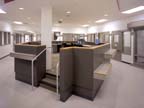
One example: Steele County Detention Center, in Owatonna, Minn., was recently honored by the American Institute of Architects’ Committee on Architecture for Justice as one of the top 40 justice projects in the nation.
Designed by KKE Architects Inc., the project also received the Governor’s Award for Excellence in Waste and Pollution Prevention from the Minnesota Office of Environmental Assistance, where Steele County earned a blue ribbon as one of the top five projects in the state for the geothermal system and borrowed light in the jail. The detention center was also presented with a MN GREAT (Minnesota Governments Reaching Environmental Achievements Together) award for demonstrating economic efficiency, an innovative/creative approach, and being a model for others.

Designing security in
The 58,578-sq. foot detention center replaced the county’s existing, outdated correctional center with an innovative, energy-efficient structure capable of housing up to 160 beds. KKE’s architectural solution for Steele County Detention Center helped save $300,000 in projected energy costs, with total construction costs tipping just over $10 million.Part of that solution was Wausau Window and Wall Systems’ 1.1875-inch-thick aluminum window systems, which are break- and separation-resistant with extruded aluminum frames and hydraulically crimped corner blocks. Fitting the needs of the prison, no removable parts are accessible from the interior.
W.L. Hall Co. installed the windows, which were stacked vertically, and perimeter-sealed with hardened detention sealant and finished by Linetec in Champagne anodize. Due to anchor accessibility, the company field-glazed the laminated glass on-site.
“The new center includes some really amazing sustainability concepts that will change the face of jails in the Midwest permanently,“ said Randy Lindemann, AIA, KKE’s lead designer.
Steele County was the first Minnesota correctional facility to be approved for a so-called “borrowed light design,“ reflecting a new interpretation by the American Correctional Association (ACA) regarding windows. This means that strategically placed window walls could illuminate the structure without relying on expensive window units in every cell.
“It was a huge cost savings not to have a little glass strip in everyone’s cell,“ said Steele County Coordinator David Severson. “Instead of using all that exterior wall space for cells, we can now use it for dayrooms and recreational areas with secured outside access.“
“Ten years ago prisons were designed ‘hotel style,’ with a window in every cell. That’s why we see these crazy-shaped buildings trying to get enough exterior surface to accommodate such designs,“ explained Lindemann. “These areas are essentially the inmates’ sleeping quarters, so they often taped cardboard or put tinfoil over the windows anyway.
Secure windows
“With the ACA’s reinterpretation, we were able to exceed the daylight requirements per inmate and put the windows where they’re really needed – in the dayrooms. This made it more pleasant for both the staff and the inmates. It allowed us to make much better use of the floor space.“Severson agreed, pointing out that the design “moved the cells to the building’s interior where they have indirect light. This leaves laundry, kitchen, booking and other operations to a central core. The pods are arranged along one long hallway, so if we ever need to, the building could be expanded on either end. It’s nice and bright and very functional. It’s earth tones and tip-up construction also look like they blend in with the area’s industrial buildings.”
